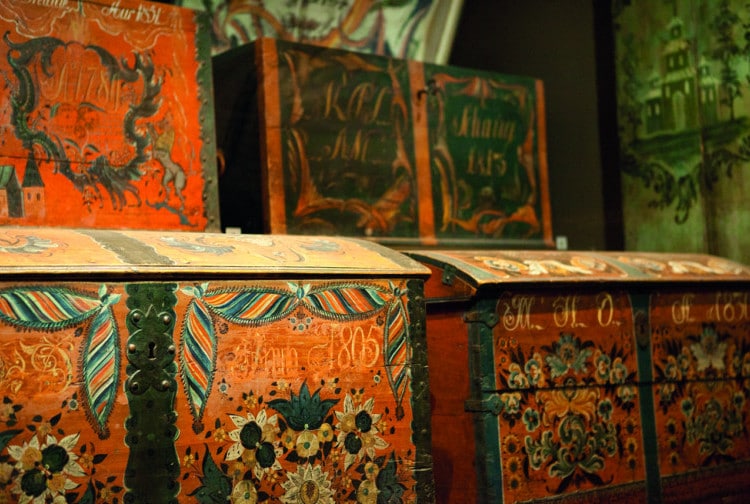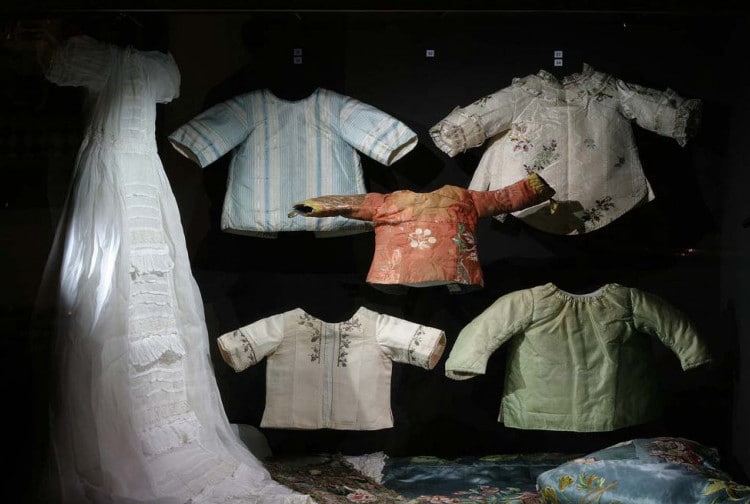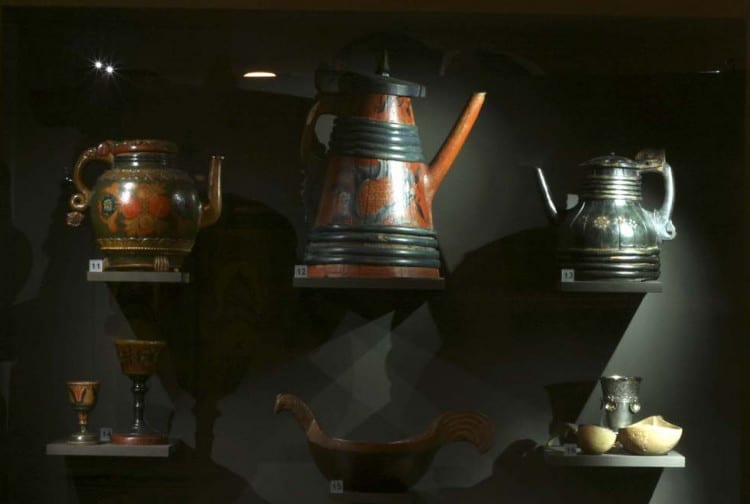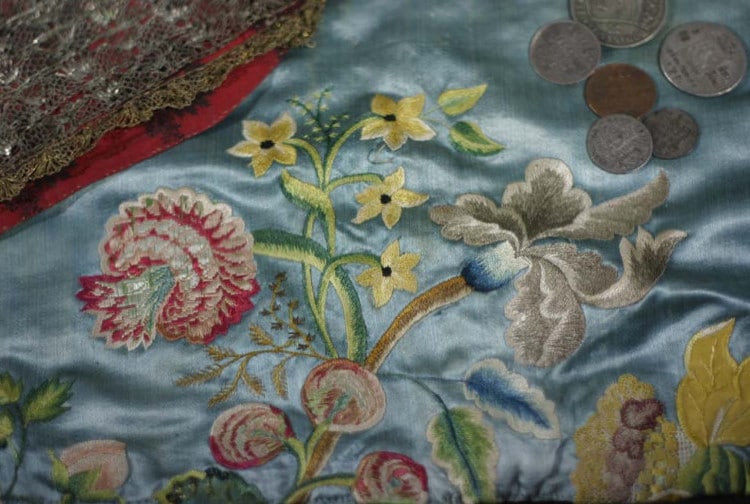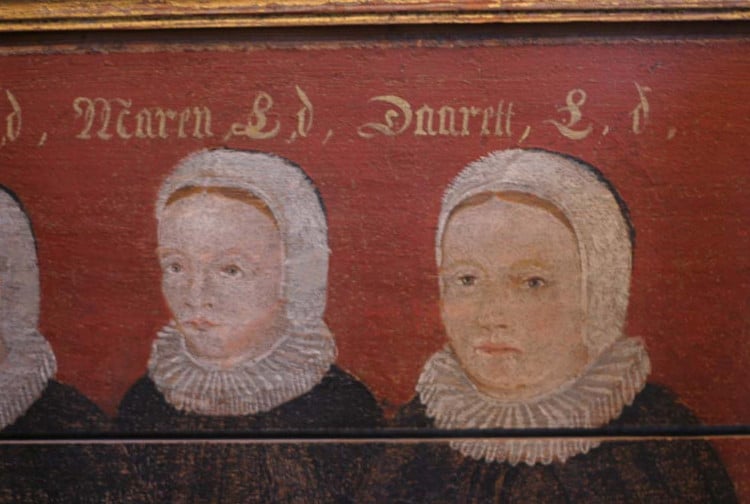Objects for life
Open all year
What sense does it make today to exhibit rose-painted cabinets from a farmhouse in Hallingdal together with interiors from the life of the big bourgeoisie in the city in the 18th century? These two categories of objects have long stood as cultural-historical pairs of opposites: the first bearing the "Norwegian" and tradition and the second associated with European fashions in fleeting and continuous change. From the culture of the peasant society we have read values, myths, history - in conclusion, our "people's character". Of bourgeois imports we read perishability, vanity and abundance.
The exhibition "Objects for Life" brings the objects together, on the grounds that they originally formed asymmetrical halves of the same mental universe. The objects were created in a society that had clearly defined rules for what functions and symbols a set of objects should reflect. In their diversity of materials and techniques, the objects show the diversity of the old society and the breadth of its object culture.
The museums have long conveyed an aspect of the objects, namely their technical variations and geographical distribution: It was seen that fashions and "styles" migrated into the country and were captured by different population groups, where they were assimilated, transformed and simplified. European imports were, succinctly, unloaded in Drammen, resold and copied so that their shape and decor can finally be read in the "folk art" in the upper valleys. Objects were thus out on a kind of geographical migration from city to country. The cultural researchers saw the style as a result of a "social" journey down through the social strata, where the forms were adapted. As the objects were tapped for fashion value in one stratum of society, they were received in the next. This is how it appears from written sources such as auction minutes how the farmers bought furniture at auction after their deceased parish priest and used it to decorate their houses.
But the objects that the museum here shows reveal that the connecting lines between the strata of society were more complicated than one usually presents it. In the populous lower districts of Buskerud, there was high social mobility and a lot of luxury goods in circulation. In 1784, parish priest Hans Strøm of Eiker moralized about the oak farmers' penchant for luxury and fashion clothes that did not suit their condition.
Society and the talking things:
But the objects also invite another story. Another form of communication can be read from the objects, namely their statement value about their owners and their social position. The objects had the task of linking their owners to life's important events. Their main functions were symbolic. They were to reflect a social order and the individual's place within it. Here is the main theme of the exhibition. It is a complex subject that requires insight into the past's view of society and the place of individuals in relation to family, government and the order of God. These conditions cannot be read by the objects alone. Neither Rococo interiors nor the farmhouse's endless varieties of rose-painted cupboards, chests, missing trees, bowls tell about the objects' original functions.
Life's great events and great contexts set the framework around people. At events such as birth, betrothal, marriage and death, human life appeared to be an important public matter. The lives of individuals and ancestors dominated the lives of individuals, as regulated by the agrarian society's seasonal cycle. The family determined who one was, because the ancestors were much more important than we can imagine today. Each individual had his allotted place in society. This "body of society" appeared as an almost organic structure that was divided into classes. Everyone had their place. Over the subjects of the kingdom towered the king, the church and the authorities. If you were born a farmer, a sailor or a craftsman, you had to live as one. With the help of clearly defined codes, signs and symbols, the social classes differed in relation to each other. At the top stood the nobility, then the church, then the citizens and at the bottom. The "doctrine of standing" was long established as part of the Order of God: In the same way that all owed Our Lord obedience and submission, each one should show respect and obedience to his parents, whether they were the parents, the teacher, the craftsman, the nobleman or the landowner. Everyone was born to their position in society, and had to manage their family as it should during their allotted time.
In the 18th century, new notions of freedom emerged, that people were born free. According to more and more people, personal qualities and skills should be decisive for what kind of position one could get. Today, it is easy to overestimate the scope of such democratic ideas. One could probably imagine that citizens could become landowners and take the highest positions in the state, but few believed that the landless poor would have an influence. It must be remembered that we first got universal suffrage in Norway in 1898 and that women got full suffrage only in 1913. In the period to which the exhibited objects refer, the 17th, 18th and 19th centuries, clear rules dominated for what members of the individual social classes could afford.
The objects are mainly created for the important events and conditions that regulated human life and subordinated the individuals to the long line of the family. In addition to their actual use value, such as storage furniture or drinking utensils, the objects had a far more important symbolic representational value. These things contain different forms of speech. And when they also show their use function, they indicate the extent of this, that there was something to store, and communicate about which families and persons have owned the object. The object's decoration therefore becomes extremely important - whether it is provided by an artist or an awkward amateur - because it describes the object's symbolic functions. The decoration communicated that the object belonged to the family or farm and that the owner disposed of them during his lifetime before they were left to the descendants. (Precisely the fact that the family "owned" the objects has led to them being preserved and eventually ended up in a museum. That this happened tells of a rupture, a paradigm shift: the objects were drained of their traditional symbolic values and a new generation left behind with bulky, inappropriate old things that had minimal use value, gave little status and only took up space. Later, the objects have regained their value, but now as "relics" and antiques with collective value).
Gifts for the big events
A number of objects are associated with church events that framed the life cycle itself: It was the entrance and exit of life, birth, first church service and baptism, betrothal, marriage and funeral.
Many of the items are gifts and constituted important symbols such as pledges of friendship and mutually binding support and affiliation. Clients built clients, but the gift was two-sided: It was a pledge of the donor's intention, but donors also expected to get something back. The recipient of the gift accepted reciprocity as an unwritten obligation. Countless engagement gifts in the form of manglers, travel boxes and embroidered wedding shirts illustrate the tradition.
The church room speaks
It is in the liturgical context of the church room that the relationship between authorities, families and individuals was constituted and maintained. The symbolic properties of private objects become clear when we insert them among the liturgical equipment of the church room. The objects refer to a social order established through the spoken word in the church room. The church formed a miniature model of society, where people were assigned a place in relation to God: Even in small "houses of God" the places were predetermined according to where one belonged in the order of society. The most powerful sat in church chairs that belonged to the family or the farm, or in the most generous church pews. Others sat up in the gallery. Ordinary women and children often sat there. As in the theater, the most generous seats were downstairs and in front and in lodges. In the large Kongsberg church, the miners sat all the way up under the attic in the upper lodge. Criminals who did not have "access" to society also did not have access to the church, but could in some places hear through a hatch in the wall. The same "class divide" applied at funerals. The finest families had their own tombs and family graves close to the church card, while others had to settle for simple burial sites.
An important concept in the old society was the Household. It was through the priest's union of man and woman in marriage that the Household was established on earth. In the church's speech, the notion of the household and householder / mother and servant is formulated. In Luther's Huspostille, society is divided into husband and servant. In all relations, between husband and servant, father and son, the relationship between God and the king and between the king and his subjects is reflected.
Another important aspect was the right to speak, which was carefully regulated. The place of the pulpit next to the altar emphasizes that the priest spoke on behalf of God and the authorities. Only the government had the right to speak, it had the exclusive right to speak the words of truth. The church commoners were to be silent, sound and let themselves be taught. Farmers and workers were at the mercy of the blessings of toil.
The objects' spoken language of signs and codes communicates the regulated right to express speech.
How objects have "spoken" on behalf of their owners (or donors) we can consider by the preserved parts of an epitaph (a memorial plaque) from Heggen church on Modum from approx. 1595-1600. The preserved base (called predella) shows the kneeling members of parish priest Lauge Thomessøn to Heggen and his household, kneeling in prayer in anticipation of the resurrection. The painted main field is lost, but probably showed a scene with the resurrection of Christ, one from an illustrated Bible version. The priest and his household, if not in the same picture field, almost as if they were present during the procession. As authorities, they are allowed to be present in the church room, represented through their portraits directly before God. If we look for the farmers, these have not been allowed to characterize the church room with their pictures. In height, it may have been about the farm name painted on a church pew. The peasants, on the other hand, are depicted on fine people's painted wall wallpapers as characters to portray "the work" or loads as "laziness". Norwegian farmers in folk costumes were first depicted by artists in the early 1800s and then as exotic. If we are to look for the farmers' own interpretations of religious scenes, we need specific objects. From coffins to beer bowls, there are Bible words applied with a squiggly brush, and we find popular klinks such as Adam and Eve on manglers and coffins.
A Halling farmer's powder horn from about the same time as the epitaph contains a depiction of Holger Danish dressed as a rider in contemporary equipment. This popular figure symbolized the good power and refers to the priest's interpretations from the scriptures. The peasant society reflected itself through being seen by others.
In this sense, it was about different communication systems and asymmetric readings. Here: The intention was that the farmers should reflect the church's words through their way of life, their customs and manners. But within his household, the farmer was the master and the wife the mistress. The central piece of furniture in the living room, the large long table with its carefully fixed table placement, was a telling metaphor for Christ and the disciples and their last meal. Here the master entered the place of Christ, and his position from the food became a reminder of Christ who split the bread. Also that one had food to present, became a tangible picture of the good household.
Over time, a richer, nuanced narrative about the owner, the family and the individual's self-will and ambitions is formed within the various social classes. It can be said that already in the early 18th century the upper class was about to vacate the church room, ie they transferred more and more church ceremonies to the home: Engagement, weddings and christenings, or ceremonies were performed at home and in the church. The farmers remained in the church (as the prints in Tønsberg's series by Adolph Tidemand illustrate).
Gifts constitute a rich artefact material that communicates status, inheritance and dowry. The objects refer to a fixed system of values through being linked to functions that pointed beyond their narrow utility significance. They were of great importance to their owners, whether they were on display in the town hall, in the farmer's chamber or in the church room. The bridal coffin was e.g. both a storage unit for bridal equipment, where shape, size, number, appearance and decorations communicated the owner's belonging to the community, her relatives and culprits. But the coffins also constituted the furnishing of stasis or guest rooms. Things spoke for an ideal reality. When the verse from the beer bowl refers to a proverb or biblical word, while the engraving on the citizen's wine glass praises individual happiness and can even express a frivolous double meaning, then it is not reality that is portrayed, but conventions for how people of different abilities should communicate.
The title of the exhibition reflects the double meaning that the objects expressed to their owners something fundamentally important for life, and that their "speech" communicated conditions where there were sanctions that could go to life.
The spatial references of the objects in the exhibition simulate cohesion and differences. Typically, mirrors were only found in civic homes, never in church rooms or farmhouses. Spiritually, however, the Norwegian farmer was completely on the sidelines. With the confirmation teaching came the law of schooling for all (1722), and many had good knowledge of reading and writing.
Baptism:
All people, regardless of social status, were present around the baptismal font, framed by the same ritual.
The wedding was the public union of two families (bridal casket, equipment, courtship gifts). For the future spouses, the betrothal was the decisive, initial event. Mutual gifts in the form of mangle, from the man, and bridal shirt, from the woman, served as symbols of their future roles. The execution of the objects also served as a "test" of their skills in the role of housekeeper and housewife, and the execution of the gift should also show an opulence.
Real gifts from others, relatives and friends, are a recent bourgeois phenomenon. At the peasant wedding, two models were common: Either the guests brought their own food and drink to the wedding ("leadership wedding") or money was put according to rank and ability in a bowl ("bowl gift wedding"). In bourgeois circles, it became common to give gifts similar to the tradition of our time. One could for example give a dresser or a piece of jewelry. Usually you gave away things you already owned.
For the bourgeoisie, individual portraits became a tool for communicating over geographical distances relatives, influential patrons and clients. Portraits and eventually photos of the peasant family therefore lead to the explosion of older social codes. Similar features had jewelry, which long served to individual identification. In the peasant society's national costume (bunad) lay a requirement to subject the individual to a unified society.
The contrast is great between the farmers' objects and bourgeois gifts that were to a far greater extent geared towards the individual. The objects reveal the citizens' growing interest in individual freedom, in contrast to the conservatism of the peasant society. Here you can read different considerations of the life course. For the bourgeoisie, the progress and change was significant, because their industries were the result of greater conditions, while the farmer's living conditions were regulated by the wheels of the seasonal cycle and eternal cycles.
The individual's place in society also emerged clearly at death. The excavation equipment was a direct measure of one's condition and position. Originally, only nobles were allowed to be buried in leather-covered coffins, and it is known by farmers who did the same were fined. The priest's funeral sermon established the individual's position and characteristics.
The skills in reading pictures and text are very different between the social classes. In the peasant society, the Enlightenment as well as 19th century commercialism had little literary impact. The pictures they were dealing with reflect in disdain for the old Orthodox books (Examples of Coffin Letters, "Heavenly Letters").
Examples of such orthodox "text" are the prim staff, which was also read aloud; it was text literally.
Folk art
Decorated objects from the peasant society go under the name folk art. It is a strange word, because all art is made of "people", but folk art means that people, a group of people socially or geographically defined, are collectively behind the art. Folk art means that things are made by many people with different skills, but who still follow a kind of "recipe". There were no established artists associated with a guild that was behind folk art, but inherited skills and tradition, old motifs and techniques that were handed down from generation to generation and that required little equipment to realize. The decoration applied to the objects by means of a knife or brush refers to diligence and effort. Then idleness was the same as laziness and neglect. Should the individual use the time for diligence and demonstrate his good intentions and his immaculate qualities.
The rose painter and the city painter
When descendants of Norwegian emigrants in the USA have to make something typically Norwegian, they use rose paint. Rosemaling has long been an expression of something genuine, nationally Norwegian. In brief, rose paint is the decorative painting from the countryside. Such paints are preserved as decorated walls, panels and ceiling decor, furniture and fixtures, and not least, on countless small things in wood: beer bowls, saucers and jugs. But the rose painting also has a distinctive character that makes it reasonable to tighten up on the definition: the motifs are mainly ornamental, even though figure scenes appear in abundance. The motif's focus is the ornamental rose which is surrounded by meandering plant ornamentation. The rose painting is characterized by the fact that it copies, simplifies or spins freely around motifs that were common in 17th and 18th century large or "tall" art and interior decoration. It is common to set the beginning of rose painting to around 1700. Its peak is the time from the end of the 1700s to the middle of the 19th century. The rose painting continued throughout the 19th century, and is still practiced, but after around 1900 the rose painting ceased to be part of interior decoration.
With this narrower definition of rose paint, it is natural to call the decorative paint in civil and official environments as simple decorative paint. Some call this "guild art", but it is an inaccurate term because few of the painters in question belonged to any guild. It is difficult to draw a sharp distinction between the works of the various artists. In the 1700s, the motifs are related, with naturalistic plant motifs taken from the great art. But then the rose painting develops according to a kind of backward chronology by cultivating linear plant ornamentation, at the same time as the three-dimensional picture space dissolves. We find few of the classicist elements that increasingly dominated the bourgeois and civil society environment.
The actual rose painting belongs in a geographical belt that extends from Østfold over Eastern Norway and down towards Agder and Rogaland. Gudbrandsdalen and most of Western Norway are outside the area. Hallingdal and Telemark were the districts where rose painting was most widespread and reached its distinctly typical shape, many would also say - the highest quality. Rose painting was also widespread elsewhere, such as in Numedal and Valdres.
Several properties of rose painting have given it status in the reputation of Norwegians. In the tradition, the rose painter was a farmer's son who painted as a staple with a farm or homestead next to it. The rose painter belonged to the peasant community and worked within it. He worked for a local clientele and had acquired the art from a well-known rose painter. The best left behind jobs in several valleys. In retrospect, the rose painter has interpreted it to mean that the skills are based on a combination of tradition and one's own abilities. Both of these characteristics describe something positive in Norwegian folk character, both being true to tradition and daring to add something original within the framework of "custom". The rose painter got his place in our hearts by not copying the great art, but reshaping it according to his national orientation. Perhaps that is why cultural researchers have been careful to show district-specific differences in the rose painting between the valleys, in the same way as within the costume and building customs. The rose painting was perceived as a regionally determined collective expression of art, color vision and taste. At the same time, we are struck today by how the rose painting also opened new horizons and embarked on a challenging theme. We find Admiral Nelson side by side with Holger Danske. The rose painters could throw themselves into it, with bold motifs and colors.
City and village painters
It is little known whether the "city painters" who worked in Norway in the 18th century belonged to any painting guild. Among the most well-known practitioners are German, Danish or English names. Many immigrated to Norway to carry out important assignments at churches and residences. The names are known from the church accounts, and many of their works are identified and known today. Less is known about what these performed on other assignments around farms and in cities. In the middle of the 18th century, well-known names such as the priest's son from Land, Peder Aadnes and the Swede Eric Gustav Tunmarck, who at least lived in Drammen for at least some time. Their most important private customers were the bourgeoisie, and in their homes they had to compete with purchased imported wallpaper, furniture with inlaid decor, paintings and copper engravings. With illustrated books in the closet, these customers were also able to check the artists' skills and critique the results. For these reasons, these painters also found that it was much easier to make ornamental decor than human figures! And what one did not master in technique could be compensated with colors, imagination and a sense of decorative and fun effects. Preserved decor on furniture seems to confirm that these painters did not go out of their way to practice pure decorative painting.
But today's reluctance to copy is not old, and it is unlikely that artists before 1850 perceived copying as something negative, on the contrary. Well-known rose painters were also commissioned to adorn the parish churches. Here the village painter met the city painter with whom he obviously competed for assignments. We now know that the city painters, those who were mainly commissioned in the cities and by the citizens, were not always better educated than the village painters. Nor do they seem to have been particularly wealthy. They used copperplate engravings and illustrations from which they copied motifs. They simplified the representation of figures according to their skills so that the execution could be completely unrecognizable in relation to the publishers. It's easy to see their artistic limitations, and they used tricks to get around difficult challenges.
It is hardly possible to draw a clear distinction between the "city painter" and the "rose painter". The first hardly painted only for citizens and the second hardly only for peasants. The differences between rose painting and other decorative painting appear less sharp if we consider the decorative painting outside the typical rose painting districts. The artists of the time were versatile and mobile, they had to practice several crafts such as carpentry and make colors themselves. They were as much craftsmen as artists.
Characteristic of the rose painting in its core areas is that the entire interior of fixed cabinets and exhibited ornaments was painted rose. The living rooms' fixed furnishings were standardized, ie the custom literally determined where the cupboard should stand and which cupboards, beds, tables and benches should be present in the living room and in the guest rooms. When also wall panels and ceiling were painted, the rose-painted decor appears as an expression of an old tradition. In Norway, the tradition of painting interiors can be traced back to the homes of 16th-century nobles and city dwellers. Initially, this paint imitated tapestries and draperies.
The great rose painters
The great story of the rose painters is built around well-known, named "masters" who are identified by their style. Some signed and dated works form the basis for identifying each artist's painting style and use of motifs, which in turn can be used to identify other works, preferably in the district. Many chests and beer bowls have painted name inscriptions and dates. The problem occurs when something is similar, but not quite. Is it then the same painter you think you can identify, and does the variation show influence from other painters? Or are we facing a student or successor who has learned from the master and is now practicing on his own? Based on such considerations, connoisseurs have found that famous artists formed "school", ie they got successors who also added their personal touch. Of course, it is difficult to determine whether an artist has changed his style a bit or whether the work has been done by an assistant or successor. Many of Drammens Museum's rose-painted objects are attributed to several masters by various connoisseurs. There were probably also artists whose names we do not now know and who therefore cannot be identified either.
Often the objects carry several layers of rose paint on top of each other. Remains of older paint can be left under the chest lid or in cupboard doors. This gives at least a chronology of painting methods.
Judging the artistic skills of these masters purely qualitatively gives many reservations. The artists simplified the role models according to their skills, and we can register their artistic limitations as charming and decorative. Today's understanding of artistic quality can only be partially applied to this material. For these folk artists, the tradition and the ability to reproduce the role models in a decorative, and probably also fast and economical way was an expression of skill. It was undoubtedly more important than creating an individual distinctiveness. But within the fixed patterns of object types and composition, great ingenuity was produced with colors and motifs.
The first of the famous rose painters in Hallingdal is Kittil Rygg (ca. 1727-1809). His acanthus curves followed in the tradition of older vine paintings from the 17th century. His clumsy figure drawings are sort of folded out in the surface, similar to children's drawings, with clear color surfaces set against each other. It is believed that his younger contemporary, Kristen Aanstad (1746-1832) who came from Gudbrandsdalen probably learned from Rygg. Aanstad introduced the C-shaped "rocaille" which is taken from the 18th century rococo ornamentation and replaced the obligatory red background color in the paint from Hallingdal with blue or green.
The great master before anyone in Hallingdal was Herbrand Sata (1753-1830). The quality of his early Rococo cartouches and naturalistic flowers suggests that he may have been apprenticed in the workshop of an established urban artist. His cabinets and chests are characterized by symmetrically constructed compositions.
Curator: Einar Sørensen
Venue
Monday to Friday 11.00 - 15.00
Wednesday 11.00 – 18.00
Saturday 11.00 – 16.00 (free admission)
Sunday 11.00 – 16.00


